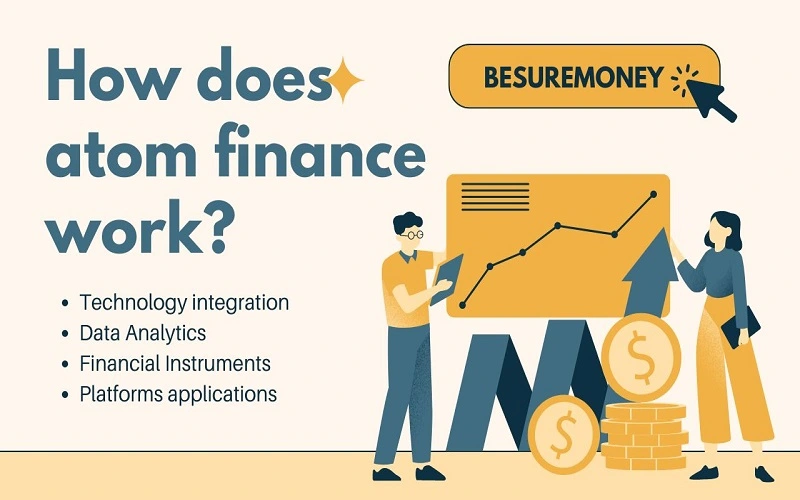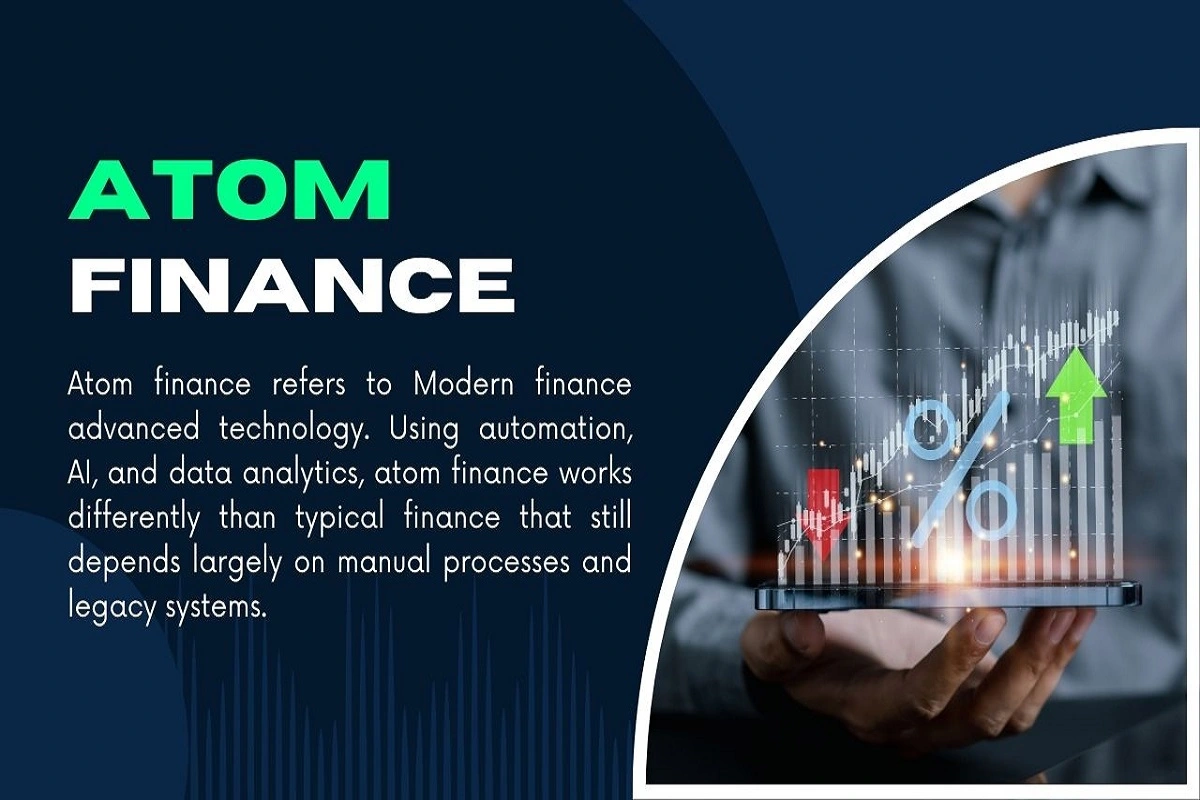Atom finance is the way of the financial world with its new methods. In this blog, we learn What atom finance is how it works benefits, what challenges are going ahead, and the future of atom finance. You will understand some financial concepts and how to join in by the end.
What is atom finance?
Atom finance refers to Modern finance advanced technology. It leverages automation, AI, and data analytics, setting it apart from traditional finance, which relies on manual processes and legacy systems.
Some of the key concepts of atom finance are:
Automation:
Software and algorithms are employed to automate financial actions with few human interventions.
Data Analytics:
Using data at scale to build great products and bring the right products and services to market.
Artificial Intelligence and Machine Learning:
Use smart systems to anticipate patterns and fine-tune financial strategies.
How does atom finance work?

Atom finance works by using technology (increase in efficiency, accuracy, and access) in all the financial processes. A more detailed breakdown of how it works follows:
1. Technology integration:
Automation:
Some highly sophisticated software automated tasks like portfolio management, trading, and compliance. This reduces human error and also improves transaction times.
Artificial intelligence:
AI algorithms can ingest massive amounts of data to gain an underlying sense of trading strategies and forecast where future market.
2. Data Analytics:
Big Data:
Packets of data are batch-processed to uncover behavioral patterns and market trends that can shine a light on decisions made in the financial world. For example, analyzing transaction histories and what has been happening in the markets is a great way to assess risk and plan investments.
Live data processing:
We obtain real-time data quickly and with minimal degradation, allowing us to predict future events at the millisecond level.
Decentralization:
Blockchain offers the security, transparency, and immutability of transactions. Its application here could become a reliable ledger for financial activities powering cryptocurrencies and other digital assets.
Smart Contracts:
Self-executing contracts with the terms of the agreement between buyer and seller being directly written into code. They are self-executing and self-enforcing agreements that work in a peer-to-peer configuration.
Financial Instruments:
Tradable Digitial Assets:
Cryptocurrencie tokens and other digital assets can be traded on blockchain platforms.
Traditional Instruments:
Traditional financial instruments like stocks and bonds are even managed more efficiently with atom finance platforms enabling advanced analytics and trading tools.
Platforms applications:
User Interfaces:
Atom finance platforms offer user interfaces that enable users to manage their finances, no matter their level of financial expertise
Traditional finance integration:
Atom finance platforms frequently integrate with existing banking and investment services, acting as a bridge between the old and new financial systems.
What are the benefits of atom finance?

Atom finance’s primary significance lies in the potential to revolutionize the finance industry for customers, individuals, and enterprises. The key benefits are as follows:
Efficiency and Speed:
Quick Transactions:
Automated processes and real-time data analysis mean quicker transactions than regular finance.
Less Manual Work:
Automation means less manual work, fewer mistakes, and faster financial operations.
Cost Reduction:
Reduced Fees:
Automation and efficiencies in processes bring down operations costs, leading to reduced fees for users.
Economies of Scale:
AI and data analytics technologies help companies to handle more transactions without increasing costs.
Increased Transparency and Security:
Blockchain technology:
All transactions, no matter the size, are recorded on a secure, transparent, and reliable decentralized ledger, reducing the risk of fraud.
Accessibility/ Inclusion:
Ease of Use:
Financial tools are less daunting due to easier-to-understand interfaces, accessible to multiple stakeholders, including those with limited financial literacy.
Democratize finance:
Atom finance makes it possible for more people to actively invest their money in the market by lowering barriers to entry
Enhanced decision-making:
Data-driven insights:
Advanced data analysis with user data to leverage insights to make more informed financial decisions.
Predictive Analytics:
AI models that can predict open market trends and investment opportunities to make the future strategy of a business.
What are the challenges and risks of atom finance?
While atom finance offers numerous benefits, it also comes with its own set of challenges and risks that need to be carefully managed:
Risks & Vulnerabilities:
Cybersecurity Threats:
With the number of digital platforms increasing, Atom Finance is more vulnerable to hacking, data breaches, cyber-attacks, and other security threats which would result in damage to more significant reputation or money.
Problems with Technology:
Our reliance on technology gives the possibility of any kind of malfunction, technical failure, or service-disrupted losses in financial services.
Legal and compliance concerns:
Regulations Evolving: Since Atom Finance is a newer company, the regulatory framework surrounding it is also changing and may need to be clarified for companies using this product and investors who choose to invest in businesses that use Atom Finance data.
Compliance costs:
Staying with the rules in different places can be hard and costly, especially when it is a worldwide business
Market Volatility and Liquidity Risks:
Medium to High Volatility: We also need to bear in mind that, digital assets, basically cryptocurrencies can be quite volatile and almost impossible to predict their stable value causing massive loss of funds
Liquidity risks:
In some markets or during volatile times, the market can become less liquid, and it becomes harder to buy/sell at intended prices promptly.
Operational risks:
Reliability on Algorithms:
If systems are programmed using algorithms and are automated, if the systems fail or produce errors in data – it could risk conventional dependencies.
Human Oversight:
In the most automated IT environment, humans still need to oversee and manage exceptions and unexcepted events which presents a challenge.
What is the future of atom finance?

The development and progress in atomic finance will continue to shape our financial future positively. Here are some key predictions and expected trends
Emerging Technologies:
AI and Machine Learning:
These improvements will make predictions more detailed and accurate. They will improve customized banking services and sharpen investment tactics.
Blockchain & DLT:
Ensures secure, transparent, and efficient transactions. These ideas in DLT can help realize the potential for more mainstream Defi applications.
Integrating Traditional Finance:
Hybrid Models:
Traditional financial institutions are expected to embrace atom finance technologies, resulting in hybrid models, taking the best from both sides. Below are some additional benefits: Increase efficiency reduce cost Improve user experience.
Regulation Support:
Regulators are getting more involved, which means having clear rules and regulations that support innovation in finance, particularly in areas like Atom Finance, while also protecting consumers.
Greater Access and Inclusion:
Financial Inclusion:
Atom finance could bring you banking, credit, or investment solutions in the past not available for those people with this platform.
Easy to use:
Making atom finance tools more user-friendly meaning improvements in UI design will allow more people to manage their finances efficiently within a few clicks.
Security and Privacy Improvements:
Next-Gen Security Layers:
Cyber dangers are always changing, so the military requires news and advanced security measures that can keep up. We will probably witness more advanced encryption, authentication, and fraud detection technologies.
Privacy-Focused Innovation:
Advances in federated learning could safeguard user data and enable consumers more control over their privacy.
Conclusion:
Atom finance is changing the face of the financial industry with the technologies it ingredients: AI, Blockchain, Automation, etc. There are many advantages it is practiced effectively, is genuine, and encourages access with minimal effort. However, it also has its own set of difficulties, like security risks and licensing issues, despite the long product development cycle.
FAQs:
Q1. Is Atom a secure bank?
Ans: Atom Bank is a retail bank that’s regulated by the prudential regulation authority and covered by the FSCS which means your money is safe with them.
Q2. Does Atom Bank do credit checks?
Ans: With Atom Bank we do a little soft check when you open your savings account so this will not be registered on your credit record.
Q3. What is the minimum balance for Atom Bank?
Ans: Our Instant Saver has no organizational conditions and is opened on the terms of a voluntary saving at the latter. With our app, your savings never leave your side 24/7 whenever you need them.
Q4. Does Atom Bank pay interest monthly?
Ans: Interest is payable to a monthly interest product on the day of the month in which you opened your account. The annual gross interest is based on the assumed deposit amount as above, and for products with an interest rate that’s already been paid over a year, interest will be payable from the anniversary of the account opening. For all other products where interest is not paid within a year, interest will be payable at the end of a term.
Q5. How good is Atom Bank?
Ans: Atom has been much absent from the best buy savings tables this year, though has come back with a bang. They delivered some of the first positive net interest margins by earning more on borrower interest than they paid out in savings.
